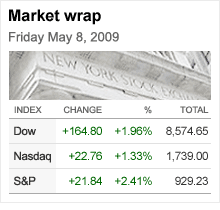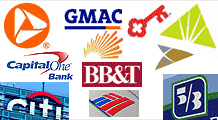Wall Street extends the rally
Stocks advance on the day and week after April's job losses are not as bad as expected and stress test results are finally released.

NEW YORK (CNNMoney.com) -- Stocks surged Friday, extending the two-month rally, after a government report showed employers cut fewer jobs than expected last month. The release of the long-awaited bank stress test results also gave the market a boost.
The Dow Jones industrial average (INDU) gained 165 points, or 2%, ending at the highest point since Jan. 9th. The S&P 500 (SPX) index rose 22 points or 2.4%, ending at the highest point since Jan. 6. The Nasdaq composite (COMP) added 23 points, or 1.3%.
The major gauges ended higher for the week as well. The Nasdaq has now ended higher for 9 weeks straight. The Dow and S&P 500 have now ended higher for 8 of the last 9 weeks.
Stocks have been rallying since early March, as investors have bet that the worst for the economy and financial sector has already happened. The S&P has jumped 36% since hitting a more than 12-year low on March 9th.
Although the jobs report was not positive, it could have been worse, said Jim Dunigan, chief investment officer at PNC Wealth Management. That appeared to be sufficient reason to get investors back into the market.
"We seem to be turning a corner here with the pace of the contraction in both employment and the overall economy," he said.
After the close, Warren Buffett's Berkshire Hathaway (BRK.B) reported a steep drop in first-quarter profit that beat forecasts on a per-share basis.
Employment report: Employers cut 539,000 jobs from their payrolls in April, the Labor Department reported Friday morning, surprising economists who were looking for job cuts of around 600,000. Employers cut a revised 699,000 jobs from their payrolls in March.
It was the smallest number of job cuts since last October, when the economy lost 380,000 jobs. However, it brings the total numbers of jobs lost to 5.7 million since January 2008. The recession is considered to have started the month before that, in December 2007.
The unemployment rate, generated by a separate survey, rose to 8.9%, as expected, from 8.5% in March, the worst reading since September 1983.
"In absolute terms it was a pretty poor report," said Joshua Shapiro, chief U.S. economist at Maria Fiorini Ramirez Inc.
He said it wasn't as bad as the ones that preceded it, but that it was helped partly by short-term factors such as a big increase in government jobs added to conduct the 2010 census.
"The overall employment picture is still bad, but I think people are looking at leading indicators such as weekly jobless claims, which have been declining," he said. "That could mean a better payrolls report in May."
In other economic news, wholesale inventories shrank for the seventh consecutive month in March, falling to $411.7 billion, the lowest level in 16 months.
Financials: The government released the results of the stress tests late Thursday, saying that 10 of the 19 banks tested will need to raise almost $75 billion in anticipation of a deeper recession.
Leading the list was Dow component Bank of America (BAC, Fortune 500), which needs to raise nearly $34 billion. Wells Fargo (WFC, Fortune 500) needs $13.7 billion and Citigroup (C, Fortune 500) needs $5 billion.
JPMorgan Chase (JPM, Fortune 500), American Express (AXP, Fortune 500) and Goldman Sachs (GS, Fortune 500) were among the banks that won't need to raise any additional money.
The stocks rallied as investors breathed a sigh of relief that the results weren't worse.
The KBW Bank (BKX) sector index added 12.1%.
"The dollar amounts are in ranges that had either been leaked or suspected and there seems to be a pretty orderly resolution to the outcome," Dunigan said. "The other part is that investors are just happy to have it behind them."
Company news: Fannie Mae (FNM, Fortune 500) reported a loss of $23.2 billion in the first quarter, or $4.09 per share, worse than a year ago. The mortgage finance company also said it needs an additional $19 billion from the government.
After the close Thursday, AIG (AIG, Fortune 500) reported a quarterly loss of 97 cents per share versus a loss of $1.41 a year ago. Analysts thought AIG would report a loss of 6 cents per share. The stock inched higher Friday.
Market breadth was positive. On the New York Stock Exchange, winners beat losers by more than five to one on volume of 1.9 billion shares. On the Nasdaq, advancers topped decliners three to one on volume of 3.08 billion shares.
Bonds: Treasury prices rose, lowering the yield on the benchmark 10-year note to 3.28% from 3.32% Thursday. Treasury prices and yields move in opposite directions.
Lending rates continued to fall. The three-month Libor rate fell to an all-time low of 0.94% from 0.96% Thursday, according to Bloomberg.com. The overnight Libor rate fell to 0.23% from 0.24%. Libor is a bank lending rate.
Other markets: In global trading, Asian and European markets both ended higher.
In currency trading, the dollar fell versus the euro and the yen.
U.S. light crude oil for June delivery rose $1.92 to settle at $58.63 a barrel on the New York Mercantile Exchange.
COMEX gold for June delivery fell 60 cents to settle at $914.90 an ounce. ![]()


